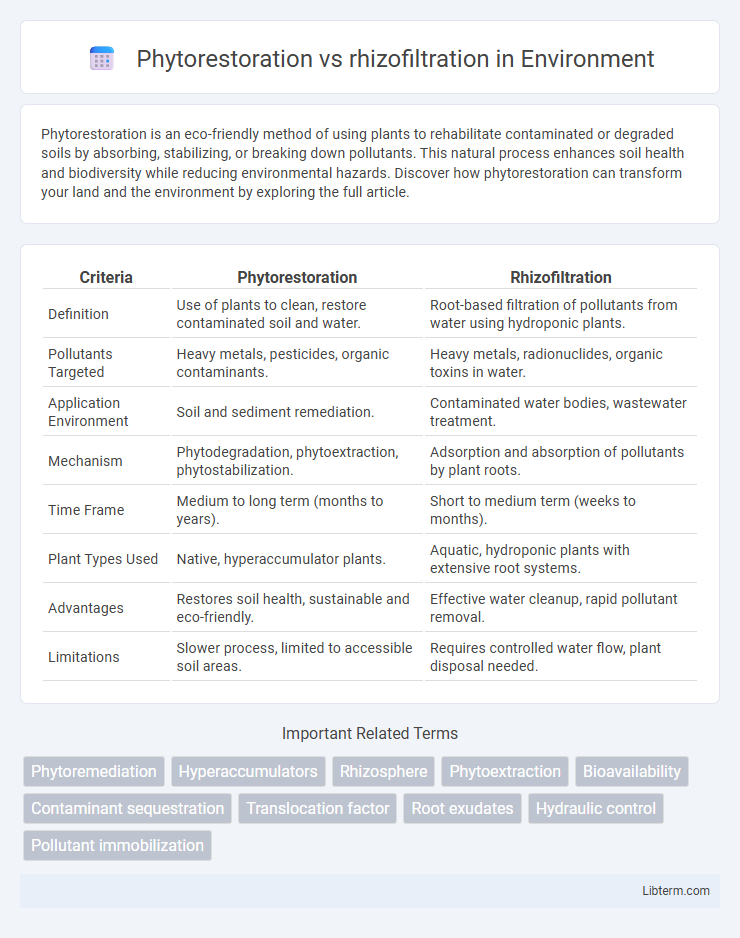Phytorestoration is an eco-friendly method of using plants to rehabilitate contaminated or degraded soils by absorbing, stabilizing, or breaking down pollutants. This natural process enhances soil health and biodiversity while reducing environmental hazards. Discover how phytorestoration can transform your land and the environment by exploring the full article.
Table of Comparison
| Criteria | Phytorestoration | Rhizofiltration |
|---|---|---|
| Definition | Use of plants to clean, restore contaminated soil and water. | Root-based filtration of pollutants from water using hydroponic plants. |
| Pollutants Targeted | Heavy metals, pesticides, organic contaminants. | Heavy metals, radionuclides, organic toxins in water. |
| Application Environment | Soil and sediment remediation. | Contaminated water bodies, wastewater treatment. |
| Mechanism | Phytodegradation, phytoextraction, phytostabilization. | Adsorption and absorption of pollutants by plant roots. |
| Time Frame | Medium to long term (months to years). | Short to medium term (weeks to months). |
| Plant Types Used | Native, hyperaccumulator plants. | Aquatic, hydroponic plants with extensive root systems. |
| Advantages | Restores soil health, sustainable and eco-friendly. | Effective water cleanup, rapid pollutant removal. |
| Limitations | Slower process, limited to accessible soil areas. | Requires controlled water flow, plant disposal needed. |
Introduction to Phytorestoration and Rhizofiltration
Phytorestoration involves the use of plants to remediate contaminated soils by stabilizing, extracting, or degrading pollutants, making it an eco-friendly approach to environmental cleanup. Rhizofiltration specifically targets water pollution, using plant roots to absorb, concentrate, and remove heavy metals and toxic substances from aqueous environments. Both techniques leverage the natural capabilities of plants but differ in application, with phytorestoration focusing on soil and rhizofiltration on water remediation.
Defining Phytorestoration: Concepts and Applications
Phytorestoration involves using plants to rehabilitate contaminated soils or ecosystems by enhancing biological activity and restoring nutrient cycles, whereas rhizofiltration specifically targets the removal of heavy metals and pollutants from aqueous environments using plant roots. Phytorestoration applies broader ecological principles for site recovery, including phytostabilization, phytoextraction, and phytodegradation, making it a comprehensive approach for long-term environmental remediation. This approach leverages plant species adapted to degrade, extract, or immobilize pollutants, optimizing ecosystem recovery in contaminated terrestrial habitats.
Rhizofiltration: Mechanisms and Processes
Rhizofiltration is a phytoremediation technique that involves the use of plant roots to absorb, concentrate, and precipitate contaminants from aqueous environments, particularly heavy metals and radionuclides. The process relies on root surface adsorption, active uptake, and intracellular sequestration mechanisms to immobilize pollutants within root tissues, preventing their bioavailability and facilitating removal from water systems. Key factors influencing rhizofiltration efficiency include root biomass, metal speciation, water pH, and the presence of root exudates that enhance metal chelation and uptake.
Key Differences Between Phytorestoration and Rhizofiltration
Phytorestoration involves the use of plants to rehabilitate contaminated soils by stabilizing, extracting, or degrading pollutants, while rhizofiltration specifically targets water purification through the absorption and adsorption of contaminants by plant roots. Phytorestoration is often applied to soil remediation with complex pollutant mixtures, whereas rhizofiltration focuses on removing heavy metals and radionuclides from aquatic environments. The primary distinction lies in their environmental applications and mechanisms: phytorestoration addresses land-based contamination broadly, and rhizofiltration concentrates on water treatment via root systems.
Plant Species Used in Phytorestoration vs. Rhizofiltration
Phytorestoration primarily employs hyperaccumulator plants like Indian mustard (Brassica juncea) and poplar trees (Populus spp.) to extract or stabilize contaminants in soil. Rhizofiltration utilizes aquatic plants such as water hyacinth (Eichhornia crassipes) and duckweed (Lemna minor) that efficiently absorb heavy metals and pollutants from contaminated water. The choice of species is critical, with terrestrial plants favored for soil remediation in phytorestoration and hydrophytes selected for water purification in rhizofiltration.
Environmental Benefits of Phytorestoration
Phytorestoration enhances soil health by using diverse plant species to stabilize, detoxify, and restore contaminated or degraded land, promoting biodiversity and ecosystem resilience. It improves water quality through natural filtration processes and supports carbon sequestration, mitigating climate change impacts. These environmental benefits contribute to sustainable land management and long-term ecological balance.
Efficiency and Limitations of Rhizofiltration
Rhizofiltration is highly efficient in removing heavy metals like lead, cadmium, and uranium from contaminated water through the adsorption and absorption processes of plant roots, especially using hyperaccumulator species such as Indian mustard and sunflower. However, its limitations include reduced effectiveness in water bodies with fluctuating pH and temperature, potential bioaccumulation toxicity affecting plant health, and slower pollutant removal rates compared to some conventional chemical treatments. Whereas phytorestoration broadly encompasses the use of plants to restore contaminated soils and water, rhizofiltration specifically targets water purification, making it a more specialized but sometimes less versatile method.
Case Studies: Successful Projects in Phytorestoration and Rhizofiltration
Case studies of phytorestoration highlight projects like the restoration of the Chernobyl Exclusion Zone, where native plants have been used to immobilize radionuclides, and the reclamation of mining sites in the Appalachian region using hyperaccumulator species to reduce heavy metals. Rhizofiltration success is exemplified by experiments in industrial wastewater treatment plants in India, where aquatic macrophytes such as water hyacinth effectively absorbed heavy metals like lead and cadmium from contaminated water. Both techniques demonstrate significant potential in large-scale environmental remediation by leveraging plant-root systems for pollutant uptake and stabilization.
Challenges and Future Prospects in Plant-Based Remediation
Phytorestoration faces challenges such as slow contaminant degradation rates and limitations in treating deeply polluted soils, while rhizofiltration's effectiveness is constrained by root biomass capacity and metal bioavailability. Advancements in genetic engineering and microbial symbiosis are promising future prospects to enhance plant tolerance and pollutant uptake efficiency in both techniques. Integrating nanotechnology and precise environmental monitoring could significantly improve plant-based remediation scalability and reliability.
Choosing the Right Approach: Factors to Consider
Selecting between phytorestoration and rhizofiltration depends on contamination type, site conditions, and remediation goals. Phytorestoration suits large-scale soil and groundwater pollutants by enhancing overall ecosystem recovery, while rhizofiltration is effective for aqueous environments, targeting metal-heavy water bodies using specific plant roots. Factors such as pollutant bioavailability, plant species adaptability, and duration of treatment play critical roles in determining the most efficient and sustainable remediation strategy.
Phytorestoration Infographic

 libterm.com
libterm.com